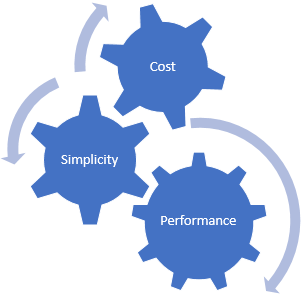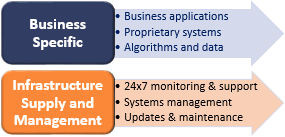 The direction of travel:
The direction of travel:
The thing about trends is that it’s never certain where they’re going to end up. If it was they would be journeys, not trends. Trends suggest a direction, like the road ahead on a murky day. Even then trends don’t necessarily tell the whole story about what might be just around the corner. You can only see what you can see.
Can you see enough to draw useful conclusions and make decisions about what to do? It all depends on how reliable the trend is, how fast you’re travelling, and how hard and awkward it would be to avoid some unexpected surprise if you ran into one.
Travel in today’s technology world is fast and the weather is murky:
Most early stage entrepreneurs and investors have grappled with the speed technology moves at. The mean time between significant changes in the business landscape is less than the time it takes to build value and exit. It’s a high risk game. Go figure.
So too the management teams in any business dependent on technology – and whose isn’t? We’re all in the same boat now. We’re all driving fast on winding roads in misty conditions, and it pays all of us decision makers to look out there carefully and draw conclusions where we can.
 Five reliable tech trends for decision makers:
Five reliable tech trends for decision makers:
In amongst all the noise, new announcements and innovations, some clear and reliable technology trends are emerging, none of which appears to have anything in the outlook that might cause a reversal within the foreseeable future. Put another way, these trends are highly likely to remain in place during any planning period that we’re grappling with.
1. Business dependency on technology is now not optional
There was a time when technology was a helpful addition, but those days are over for most organisations and this situation is not going to reverse.
At the extreme are organisations delivering an online service such as live information, eCommerce, collaboration of any kind, or a process that hooks into its clients over the network. All these are entirely dependent on the technology and smooth and reliable operation. That dependency won’t reverse, either.
There are other organisation where technology needs to be reliable in support of the main purpose. Examples of these might be policing, say, or schools and colleges, or opticians. If technology failed then the Police and tutors would find a way to continue to police and teach, and opticians would try to do eye checks, but it is getting harder and harder for such organisation to function effectively without reliable technology services. The direction of travel for these organisation is set firm towards greater dependency, not less.
2. Technology operations are increasingly on-line, real time
Looking backwards, again as a reference point, there was a time when working hours were largely defined for most organisation, and interactions were within set boundaries and real-time only during phone calls and meetings. Not so now. Mobility and connectivity lead to interactions at any and all hours, 24×7, as we all know.
Our organisations must be accessible when our customers expect it and, more often than not, this means that we must operate largely in real time. Few will be able to say this is less true now than in the past.
Most organisations will see a relentless trend towards Operations being increasingly on-line and real time, with no way back and, since organisations and technology are inextricably intertwined, technology must be always on, robust and reliable.
3. Continual technology transition will predominate, not a fixed outcome
There are many moving parts in today’s technology and business world. Competition is often coming from many different directions with new approaches, business models and propositions. New techniques and technology options are becoming available all the time. Falling costs of storage, computing power and bandwidth change the dynamics and open up new possibilities. Customer expectations are ever-changing.
All of these influences come from outside the organisation, and there are internal factors, too. New directions, markets, business avenues, product initiatives, budgeting and investment considerations. It’s all an unstable mix where change is the only thing that doesn’t change, and none of the influences appear to be in decline.
Flexibility, therefore, is a key attribute of any approach to technology, rather than aiming at some distant ideal that is never quite realised.
 4. IT stuff is growing in complexity, cost and workload
4. IT stuff is growing in complexity, cost and workload
In IT and technology there are compromises that can be made between cost, simplicity and performance, but this is a bit like a water-bed: you push it down in one place and it’ll rise up somewhere else.
There are some beguiling offerings out in the marketplace: all you can eat offers; one size fits all; get everything from us; even “free until” propositions. Most organisations with serious ambitions will be careful about being sucked in, and will examine the implications of these carefully.
If you’re serious about the future and determined in achieving, then the safest assumption to make is that complexity, cost and workload will all grow from here – wherever you are now, and wherever you’re heading.
Pragmatic solutions in practical transition plans that focus on optimising cost and performance are likely to need to meld services from different providers with existing services: Public Cloud for some attributes, Private Cloud and other hosted capacity for other capabilities, hybrid models, even on-prem.
 5. IT effort is separating into the general and the business specific
5. IT effort is separating into the general and the business specific
Two clear workstreams are emerging for organisations with important technology operations to run.
Business Specific: First and foremost are the business specific applications that must be developed, tested, deployed and maintained for the organisation and its customers. Proprietary methods, data, algorithms and functions all live in this area, and are what is responsible for delivering value to the business.
Infrastructure Supply and Management: Alongside these, of course, is the workstream that looks after the infrastructure that the business specific applications run on. The infrastructure configuration for one organisation may be different from that used by another, but the effort is predominantly the same: 24×7 health and performance monitoring, support for fixes, repairs and modifications, and routine updates and patches for continued health and security.
 |
A new breed of Managed Services Supplier is emerging:
Infrastructure supply and management is an emerging category of partner provider to off-load the non-specific workstream from busy IT teams in ambitious organisations. These providers are a new breed of MSP – right-sized, lean and dynamic, agnostic about the underlying infrastructure and so much more responsive to the challenges and needs of today’s technology dependent organisations.
Bringing in a partner like this will be highly cost effective and enables the internal IT team to concentrate on the business and add maximum value without losing control and flexibility.
Cost effective – these managed services suppliers can provide the expertise and real time cover at lower cost because it can be amortised across a larger pool of organisations.
More time to work in the business – Moving this horizontal workload to a specialist reduces distractions and compromises, and enables the internal team to spend more time focused on the needs of the business.
Wide pool of skills on tap – providers such as these are able to have a much wider pool of skills available, on tap for routine services or project execution, and that means that new services can be considered and brought on stream much more quickly and cost effectively than if experts or consultants had to be hired, and projects can be executed seamlessly.
Pragmatism is built in – the agnostic approach of these providers ensures that your organisation and its transition plan can draw from whichever services the market provides and are most appropriate for your needs.
 And Scarlett O’Hara?
And Scarlett O’Hara?
All through Gone With the Wind we saw Scarlett deal with crisis after crisis, while pinning her hopes on a romantic ideal that she couldn’t have.
After it all, in the last scene, she realises the obvious solution was there, staring her in the face, but when she reached out for it she discovered that she couldn’t have it after all – she’d left it too late.
Oh, I can’t think about that now.
I’ll go crazy if I do, I….. I’ll think about it tomorrow.
After all, tomorrow is another day.
Not the way to approach technology in today’s world.
Also:
Blog 737Max, WeWork, and how tech can deceive
Blog Pre-flight checks for business
Blog These conditions require skillful driving
Blog Make Believe Startups
Blog Are we nearly there yet?
Blog The future began a while ago
Blog Can entrepreneurialism be taught?
Blog Human engagement is a big opportunity
and
 |
 |
Peter is chairman of Flexiion and has a number of other business interests. (c) 2019, Peter Osborn
